Kaniyang Country
Wildlife watching over the last 2 years has been almost exclusively within my home state, a result of interstate border closures. This time has been used to explore Western Australia, and more recently to revisit the fabulous Marsupial Magic at Perup. The vast Jarrah-Marri forest at Tone-Perup Reserve is a wild place and contains an intriguing array of rare marsupials.
Map showing location of Tone Perup Nature Reserve.
A few years have elapsed since the last visits to Perup and this account is of wildlife seen over the searingly hot Summer of 2021-2022, when the nearby state capital Perth experienced 11 days over 40C, an unenviable record, and a sign indeed of a changing climate…
Contemplating the importance of Perup on recent trips, it is probable that nowhere in the South of the Australian Continent where the fox have taken such a terrible toll on native wildlife, does such a sheer number and boundless array of native marsupials not only survive but thrive.
This can be attributed to the humble gastrolobium plant, a toxic plant that native marsupials have developed tolerance to over time. The introduced Fox and Cat have not evolved with gastrolobium and are therefore poisoned when they predate native species that have ingested gastrolobium.
The groundbreaking Western Shield Programme has taken advantage of this and a synthetic poison developed from the gastrolobium named 1080 has been deployed to further protect vulnerable marsupials. Eradicat and Felixer Grooming Traps are recent weapons added to the arsenal to protect native species against specifically cats.
https://www.scimex.org/newsfeed/felixer,-the-grooming-trap,-works-to-control-feral-cats
Early December – Bull Banksia…
The most direct route to Perup from the state capital Perth is via Bunbury, Donnybrook and Boyup Brook, ultimately entering the forest via the Boyup Brook – Cranbrook Rd where there is a rest area called Heartlea. Heartlea is rustic day-use site that contains a (very cute but dated) information board, rudimentary toilet and picnic bench. Heartlea is where spotlighting gear is set up when arriving in the reserve after dark.
Although Heartlea is on the periphery of the forest there is usually a marsupial or two present. Brushtail and occasionally Ringtail Possums can be seen feeding in the canopy, and on one occasion late at night a Chuditch or Western Quoll wandered through. That first sweep of the spotlight into the forest to find eyeshine reflected back, is always an exciting moment.
When staying at Perup most nights are spent at the excellent Perup Nature’s Guesthouse, and indeed this was the case during this visit. Droving slowly Eastwards along Boyup Brook – Cranbrook Road to the guesthouse I spotlighted the forest from the car.
UNFORTUNATELY PERUP NATURE’S GUESTHOUSE IS CURRENTLY CLOSED……
https://www.perupnaturesguesthouse.com.au/
The Bull Banksia (Banksia grandis) is the most prolific Banksia species in Jarrah-Marri forest, and Nov-Dec is the peak flowering time at Perup. The Bull Banksia with it’s impressive flowering spike is an important nectar source for wildlife during Spring months.
Boyup Brook – Cranbrook Rd contains impressive stands of Bull Banksia, usually associated with the lateritic soils of the ridges. In these stands both Brushtail and Ringtail Possums can be found taking advantage of the nectar. It is not only marsupials that benefit from the Bull Banksia for perched on a flowering cone was a Motorbike Frog enjoying the many insects attracted to the flowers.
The Bull Banksia stand on Boyup Brook – Cranbrook Rd where Motorbike Frogs can often be found is over 500m from the nearest permanent water of the Perup River. Australian Frogs never cease to amaze, surviving here in a forest where Summer temperatures often exceed 30C.
Motorbike Frog on Bull Banksia.

Briefly exiting the car to unlock the front gate at Perup Nature’s Guesthouse, eyeshine was visible from a nearby Flooded Gum (Eucalyptus rudis.) It was a Ringtail Possum resting on a low branch. These gentle possums are usually seen feeding in the forest canopy in the early part of a night but in the later hours can sometimes be found resting quietly on horizontal limbs.
Western Ringtail Possum.

Rousing from sleep to the sound of the dawn chorus is an absolute joy at Perup Nature’s Guesthouse. I had business in nearby Bridgetown that morning, so enjoyed a casual 60km drive along Boyup Brook – Cranbrook , Corbalup and Kingston Roads looking unsucessfully for the elusive Numbat.
The return journey around midday saw an encounter on Boyup-Brook – Cranbrook Rd with Perup’s largest reptile, the Southern Heath Monitor. After pulling over to watch the large monitor lizard amble into the bush my heart sank as I saw what had attracted the reptile onto the road, a freshly killed Numbat, the victim of vehicle strike. This was devastating…
Road-killed Numbat.
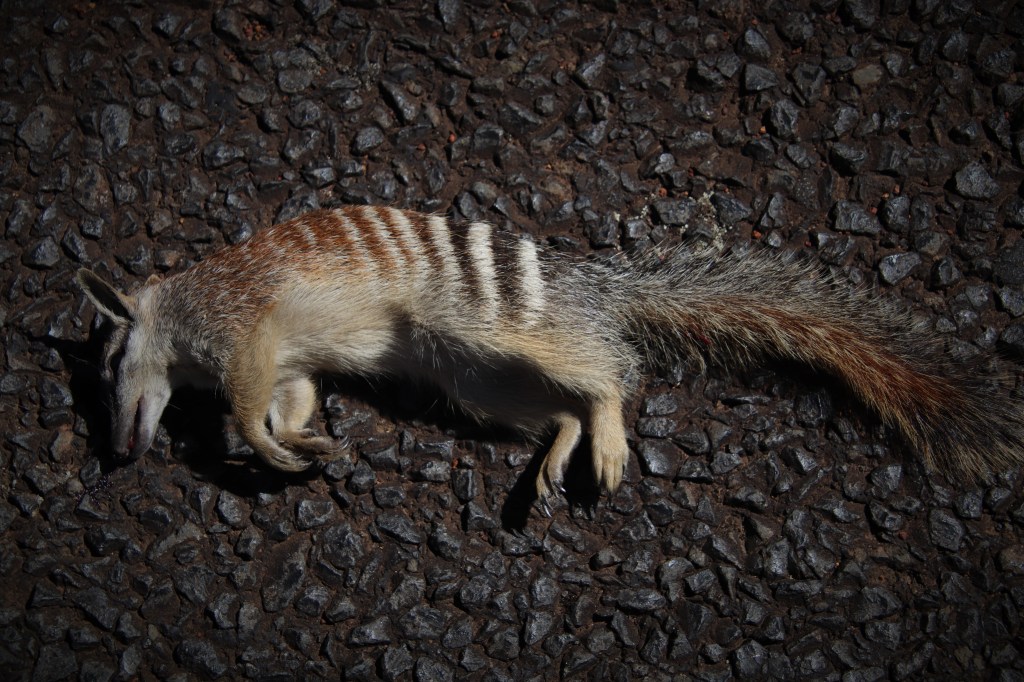
The sealed Boyup-Brook – Cranbrook Rd has a speed limit of 110 kph for the 20 kilometres it passes through Tone-Perup Reserve. This is too fast, and roadkill seen on this short stretch of road has included Numbat, Chuditch, Tammar Wallaby, Brushtail Possum, Kangaroo, Southern Heath Monitor and Western Brush Wallaby.
Traffic mitigation measures employed in Tasmania to limit wildlife death by vehicle strike include changing driver attitide, signage, rumble strips, lightening road surfaces to make wildlife feel more exposed, ultrasonic whistles, fencing and providing safe crossing in the form of overpasses and underpasses. The forest at Perup is a stronghold for endangered marsupials, more must be done….
The Eastern part of Tone-Perup accessed by Northern Road, contains lovely patches of wandoo, a result of the lower rainfall, so late afternoon with time to kill before darkness, I set off to explore this part of the forest. This resulted in a rare Western Brush Wallaby photo (my first at Perup.)
This Western Brush Wallaby is seen most often early morning and late afternoon in the jarrah forest but it is a most shy wallaby, maybe a hangover from the days when it was widely hunted for it’s attractive pelage. The habitat it is most commonly known is areas of forest with a dense understory, particularly in my experience where there are zamia ferns.
Western Brush Wallaby.
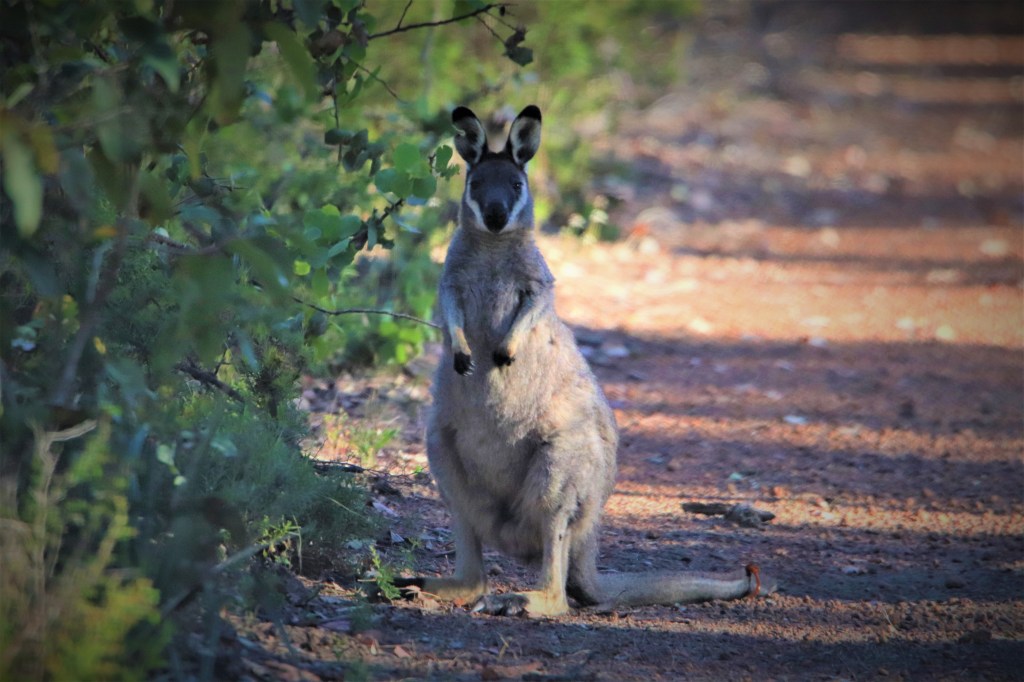
Back at the guesthouse dusk is a magical time on the verandah of Kulbardi Cottage as the oranges and pinks of sunset fade in the Western sky. Scratches and bumps from above suggest company is imminent.
Sure enough like clockwork each evening a Brushtail Possum shimmies down the post from it’s daytime sleeping quarters in the roofspace. On this visit a female was with joey. I suspect the joey was a sub-adult on the cusp of eviction from the screeches and hisses eminating from the roof earlier that day.
After nightfall I ventured out into the guesthouse grounds for a spotlight…..
The trail I spotlight most often at Perup Nature’s Guesthouse is the Bandicoot Scoot Trail, it is not only the shortest walk trail and nearest to the accommodation, but it also passes through the best habitat diversity.
Walking three loops of the 1.2km trail over the course of the evening wildlife included Western Grey Kangaroos, four Quenda, ten Woylies and three Tammar Wallabies. (The Tammars being seen later in the evening.)
Quenda (fomerly known as a Southern Brown Bandicoot.)

Mid-December – Numbat…
Two weeks later I was back at Perup for a couple of nights, as part of a greater trip into the Wheatbelt to look for semi-arid adapted Banksias. After the long drive down from Perth, the weekend started quietly.
The Bull Banksias on Boyup Brook – Cranbrook Rd were still flowering and contained plenty of Brushtail Possums. At the guesthouse I had a brief walk around before bed and encountered Woylies and further Brushtails.
Thursday was forecast to be a warm day with increasing cloud and a cool change later in the day, and by 8.30am I was driving the roads and tracks of the forest searching for some of the diurnal inhabitants.
Some days the luck is good, and today was one of those days when within 30 minutes of driving I saw a Numbat perched on a log as I was slowly driving along Boyup Brook- Cranbrook Rd. It was a male, given away by the exudate from the sternal gland that had turned the chest red in preparation for the upcoming short mating period in January.
Male Numbat.

I slowly pulled over to the side of the road and switched off the engine and remained in the car to observe this endearing little marsupial as it foraged along a series of logs sniffing for termites.
Recent research that has mapped the genome of the Numbat for the first time has found they share 95% of their DNA with the now extinct Thylacine. As I watched the Numbat move along the logs hunting for termites against a backdrop of ancient Zamia Palms, I wasn’t hard to visualise it’s now extinct close relative hunting these forests in the not too distant past.
Numbat.
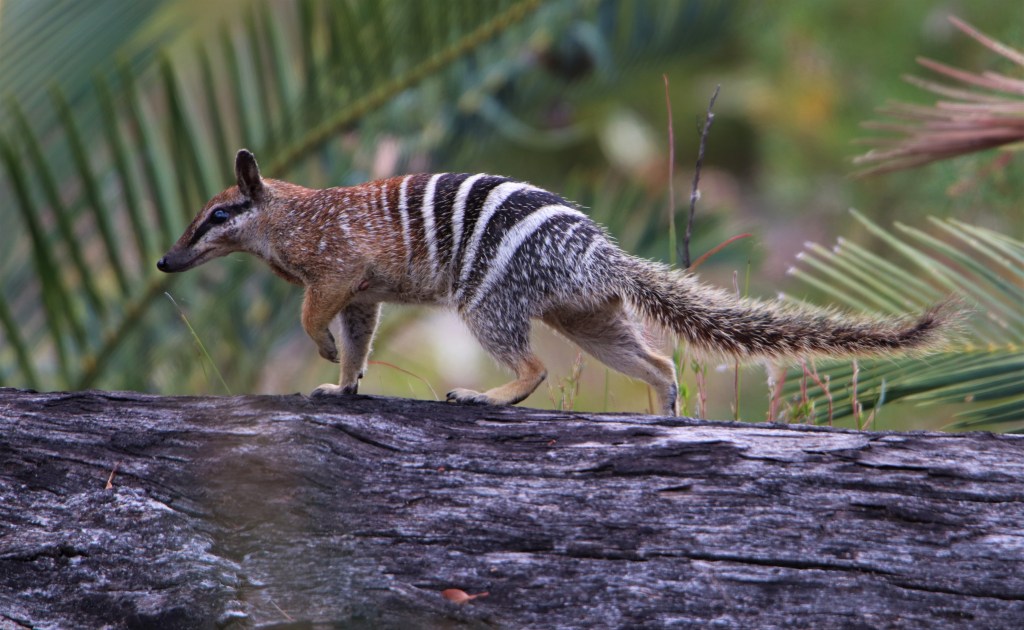
After a few delightful minutes the Numbat ambled off and disappeared into the thick understory.
A drive Northwards on Distributor Rd saw close encounters with two separate Southern Heath Monitors. Both reptiles seemed to be following a scent trail down the road. Other sightings included Western Grey Kangaroos feeding amongst the Zamias and an Emu bolting across the road
A drive into Bridgetown via Kingston Road late morning saw a beautiful Western Brush Wallaby dead on road. Kingston Rd is a thoroughfare for logging trucks and I suspect this may be how the wallaby met it’s demise.
Thankfully the Western Australian government will introduce a long overdue ban on logging of native forests in 2024 (though not mining of native forests.) This of course should be combined with the development of alternative industries for employment of the foresters.
The evening was spent on the verandah of Kulbardi Cottage, where the resident Brushtail Possums joined on dark. They really are quite habituated to humans and the encounter is always a delighfully close one.
Brushtail Possum – Kulbardi Cottage Balcony.
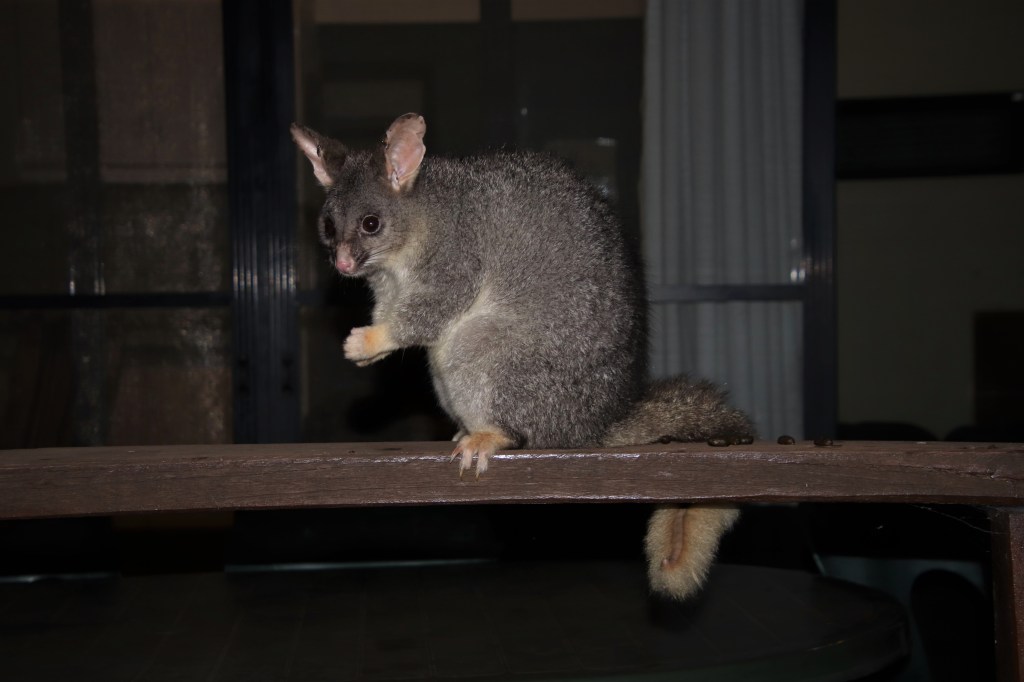
After dark I spent the majority of the evening spotlighting the grounds of Perup Nature’s Guesthouse. The evening started well when I found an adorable dark morph Brushtail Possum feeding in a young Bull Banksia.
Brushtail Possum (dark morph) feeding in Bull Banksia.
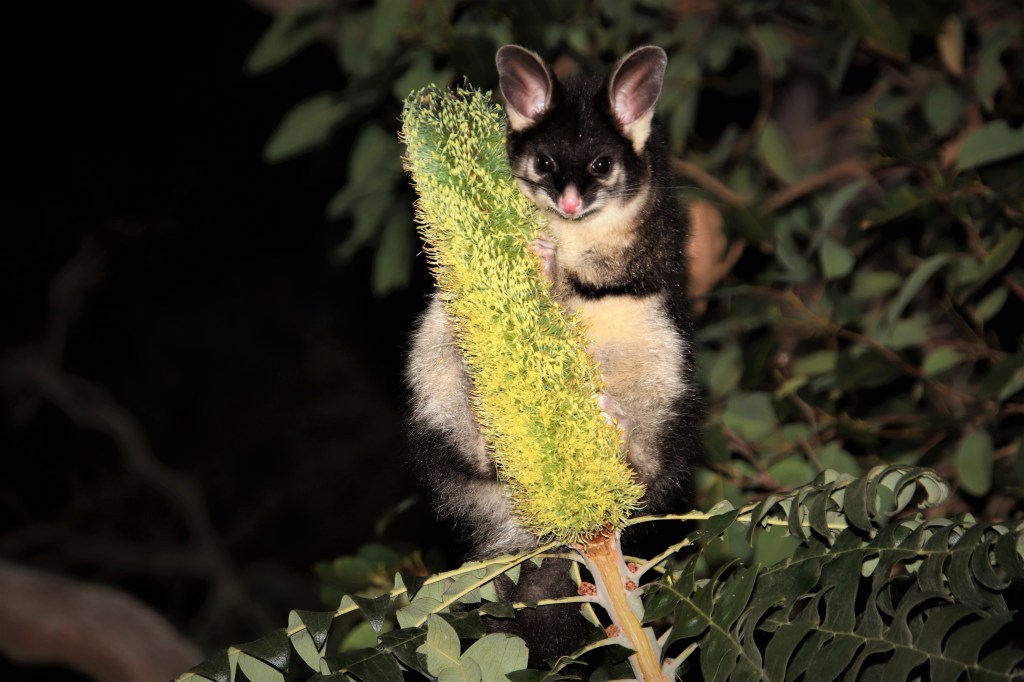
Spotlighting along both the Bandicoot Scoot and Numbat Trails Woylies, Brushtail Possums and Quenda were in good numbers. Back in the day Brushtail Possums were the most commonly encountered marsupial at the guesthouse. These days incredibly Woylies are more often encountered than Brushtails when spotlighting.
Later on in the evening three Tammar Wallabies were added to the tally, feeding in the arboretum near the old caretakers cottage (Blackwood Basin Group Office,) where they sometimes hang out.
On a whim I decided on a spotlight from the car along Boyup Brook- Cranbrook Rd to Heartlea. before bed. The only wildlife of note I saw was a Western Ringtail Possum resting high up in a marri.
At the spot where I had viewed the Ringtail Possum earlier there was a roadkilled Kangaroo on the opposite side of the road, and on approach there was movement on the carcass, it was a Chuditch!
The Chuditch climbed the bank and as I followed, it jumped briefly onto the trunk of a low jarrah as if to climb it before it thought better of it and bolted off further into the forest.
Chuditch.

Chuditch are most easily seen at Perup but can also be seen at Dryandra Woodland:-
Return to Dryandra Woodland – Pygmy Possums and Quolls.
I thought I might return to the cottage and pick-up the thermal imager to return and sit quietly and observe the Chuditch feeding. Back in the grounds of the guesthouse I couldn’t believe it when a Brush-tailed Phascogale bolted across the road and up into a small jarrah. A Numbat, Chuditch and Phascogale all in one day, this had only ever happened once before at Perup.
I retrieved the imager and watched the Phascogale as it jumped from branch to branch in the upper canopy before settling high up in a massive Marri
Brush-tailed Phascogale.
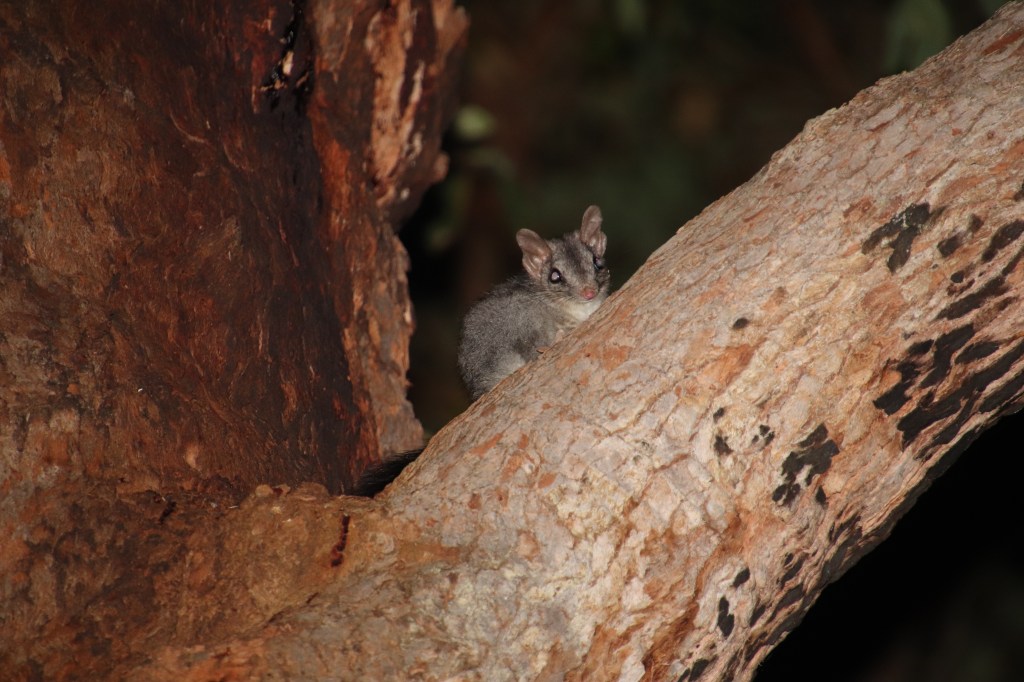
The remainder of the night was a washout when the inclement weather that had been threatening all afternoon finally broke before I could return to the carcass, and so I returned to the cottage and fell asleep to the sound of rain on the metal roof of the cottage.
Seee here for an encounter with the smaller Red-tailed Phascogale found in the the drier regions of the wheatbelt:-
Wildlife of the West Australian Wheatbelt.
The following morning I continued East to search for the Banksias…
Early January – Tammar Wallaby….
I was back at Perup on the very first weekend of 2022 and with the Friday booked off work it translated to a long weekend. Friday and Saturday night good friends Tamara Wilkes-Jones and Mike Griffiths were to join. What Tamara doesn’t know about Numbats and what Mike doesn’t know about local botany isn’t worth knowing. I was looking forward immensely to spending time with these excellent naturalists.
Thursday afternoon I made the drive to Perup after work. Arriving in the forest just on dark, I noticed that a Kangaroo that had fallen victim to vehicle strike just before Corbalup Rd. It was possible this roadkill may attract Chuditch, so investigation later that evening seemed judicious. What followed was an great night of wildlife sightings alas photographs were not forthcoming.
The first road driven that evening was Distributor Rd in a Northerly direction and I happened on four separate Ringtail Possums. At the end of the road I turned around and returned in a Southerly direction when I had a Phascogale bounce across the road and then shortly after a Chuditch. Unfortunately I wasn’t able to relocate either animal despite using both the thermal imager and headtorch.
I thermal imaged Simpson Rd and nearly stepped on a Chuditch when the heat image of the animal was camouflaged against the orange heat of the road. It jumped into a tree at the side of the road which is when it came to my attention (I initially thought it was a Brushtail Possum,) then when illuminated under the spotlight it bolted off into the forest.
It was time to pay a visit to the roadkill Kangaroo and my suspicions were confirmed when I disturbed a Chuditch off the carcass. I parked the car up and sat in the darkness and viewed the scene through the thermal imager. In this way I was able to view the Chuditch for over 20 minutes as it cautiously fed from the carcass. Chuditch are shy animals and tentative when feeding also. Anytime I turned on the headtorch, even to a low beam, the Chuditch would quickly disappear into the nearby undergrowth.
Around midnight I pulled in at Heartlea to write up notes when a fourth and final Chuditch for the night came wandering through. I’m not sure who was more surprised the Chuditch or me! It is heartening to see Chuditch doing so well at Perup, four in a night is a record, which in part can be explained by the dispersal of juvenile animals at this time of year.
That night I set up the tent and camped in the forest….
I took it easy on Friday after the previous late night, electing for a morning drive around the reserve, followed by a visit to Bridgetown to pick up supplies. Numbats remained elusive.
On a late afternoon drive up Distributor Road a Numbat crossed the road 100m ahead. Unfortunately by the time I arrived at the spot I managed only brief views before it disappeared into the undergrowth and out of sight. I had better views of a couple of Southern Heath Monitors.
Tamara and Mike arrived at 5pm and we caught up over dinner. That evening we decided on a loop of the Bandicoot Scoot Trail where Brushtail Possums, Quenda and Woylies were seen. It was great be able to photograph a Woylie using a light source other than my headtorch resulting in less eyeshine in a photo.
Woylie with pouch young.
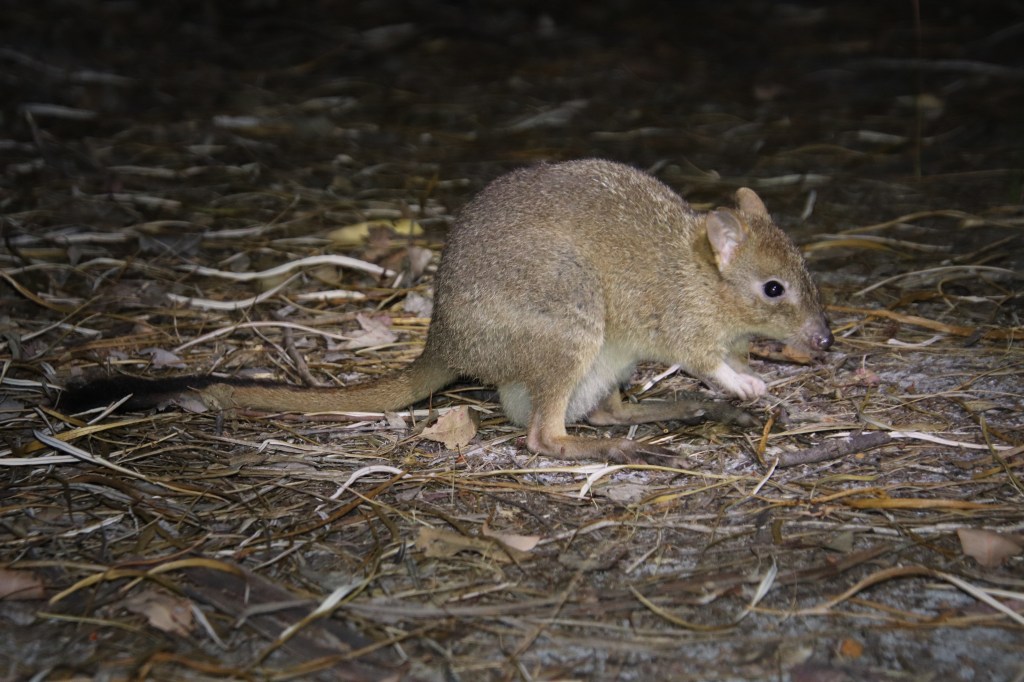
Before bed we decided to visit the roadkilled Kangaroo for a chance at Chuditch but before leaving the Guesthouse we had a Chuditch cross the road in front of the car. Unfortunately, this was the only Chuditch for the night because the Chuditch seen the previous night was absent from the Kangaroo carcass.
Saturday was spent exploring Kingston Block, an area of the forest that I am unfamiliar with outside of Kingston Rd. Despite Tamara’s excellent knowledge we were unlucky with the Numbat.
Dinner was eaten next to a dam in the forest that evening, and we were treated to a pair of Carnaby’s Cockatoos drinking after cautiously venturing down from the treetops. A really special moment, such intelligent birds!
Sunday morning we made an early morning coffee run to Manjimup to visit the excellent Southern Roasting Co. Exploring Kingston Block on the return trip to the guesthouse we didn’t find any Numbats. Tamara and Mike headed back to Perth after we had packed up and cleaned. I decided to stretch my legs before the long drive back so I walked a loop of the Woylie Walk.
As I returned to the car I noticed movement under the melaleuca thicket. It was a Tammar Wallaby, the melaleuca thicket being the place these tiny wallabies like to shelter during the day. The Tammar really is a most attractive wallaby with the white facial stripe and rufous-brown pelage.
Tammar Wallaby sheltering in a Melaleuca thicket.
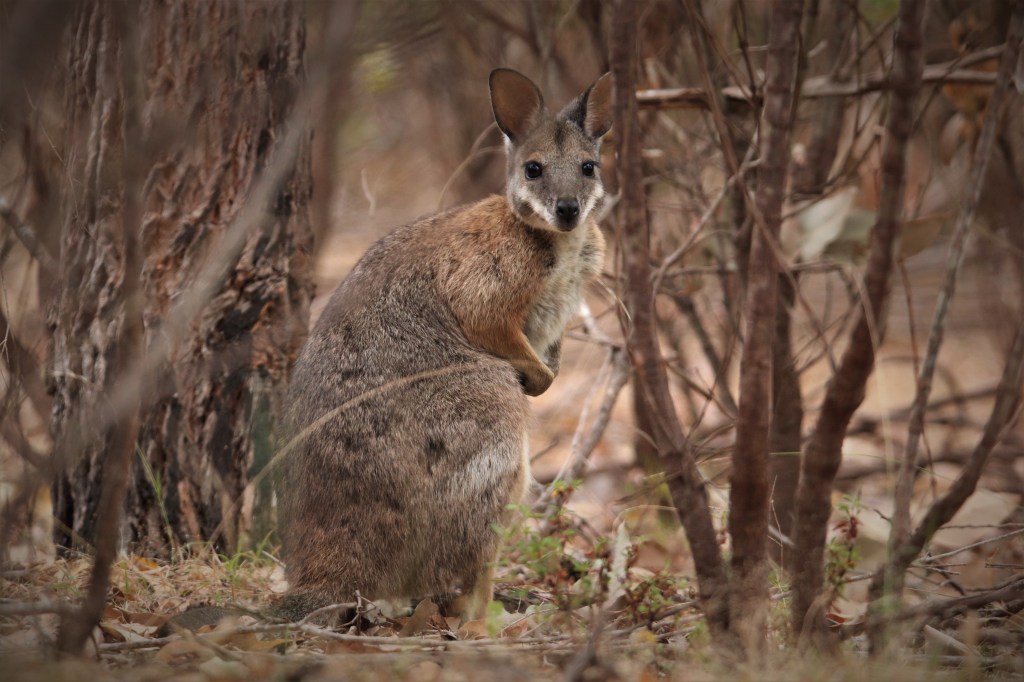
Early February – Chuditch…
Due to catastrophic fire conditions predicted over the weekend, a stay at Perup Nature’s Guesthouse was cancelled last minute in early February. Fire resources had already been diverted to an emergency near the town of Manjimup, which wasn’t to be the last for the weekend. The predicted temps were Thurs 35C, Friday 39C, Saturday 41C before a cool change on Sunday.
The hastily concocted Plan B was to stay at the pub in the nearby town of Boyup Brook, 40kms from Perup. Once unpacked I made the first of eleven 30 minute drives to the forest over the course of the weekend! On a drive on Distributor Rd a Southern Heath Monitor was seen foraging on the forest floor adjacent to the track.
Southern Heath Monitor.

The Spotlight later that night was along Boyup-Brook Cranbrook Rd where the first find was a Tawny Frogmouth perched on a low branch next to the road.
Further along the road I got eyeshine from an fast moving animal on the forest floor. Predators have the brightest eyeshine, indicating this was probably a Chuditch. Further investigation proved this to be so on approach. The Chuditch as usual took to a tree from where I could view the impressive tail of this species.
Chuditch.

On Distributor Road a Ringtail Possum was feeding in Snottygobble. Exiting the car I got further eyeshine in a second Snottygobble tree. This second animal was a decidedly scotal male!
Western Ringtail Possum.

Western Ringtail Possums are usually solitary animals, unless a female with joey, and so I think the proximity of the male correlated to the upcoming mating season.
A little further up Distributor Rd it was definitely a night for the boys, when a male Chuditch scurried up a dead tree. This animal was once again initially given away by the unmistakable bright eyeshine, combined with quick, furtive movement.
Male Chuditch or Western Quoll.

Brushtail Possums were plentiful as always, rounding off the species seen that evening. The time was past midnight, time to make the return journey to my digs at Boyup Brook.
Friday morning I was back in the forest looking for Numbats. The weather was sultry and thunderclouds dotted the sky above. I was driving along Distributor Road when a short sharp shower appeared from nowhere. This moisture on the oils of the decaying eucalypt leaves on the forest floor released that most intoxicating of aromas, the sweet smell of a Summer shower.
Further along a Numbat crossed the road 100 metres ahead. When I arrived at what I thought was the spot, I walked into the bush and stood quietly on a log hoping for a further sighting.
The Numbat was actually frozen about 2m away from me perfectly camouflaged. I remained unaware of it until I stepped off the log and the Numbat took fright and bolted deeper into the bush. Numbats it seems, are the masters of disguise.
The afternoons were too darn hot to be in the forest and so I returned to Boyup Brook to snooze the afternoon away before returning before sundown.
Sultry Sunset over Tone-Perup Reserve.

The temperature remained in the 30’s even at this late hour of the day, and so I sat quietly at Heartlea listening to the sounds of the forest settling for the night. A flock of Red-tailed Black Cockatoos screeched and squawked in the treetops somewhere nearby, eventually calming, to be replaced by the laughing of Kookaburras. All the while the rhythmic pulse of insects thrummed in the latent heat of the dying day.
The first of the nocturnal mammals to emerge well before dark proper are the insectivorous bats, hawking the rich fare of flying moths.
I spotlit Simcock Rd finding both Woylies and Tammars, all the while the call of Motorbike Frogs echoed across the riverine valley below, February being the tail-end of the mating season for this species. Eyeshine from a Snottygobble tree led to a Southern Old Lady Moth. The genesis of the name coming from the similarity of the wing patterning to the shawl of an old lady!
Southern Old Lady Moth.
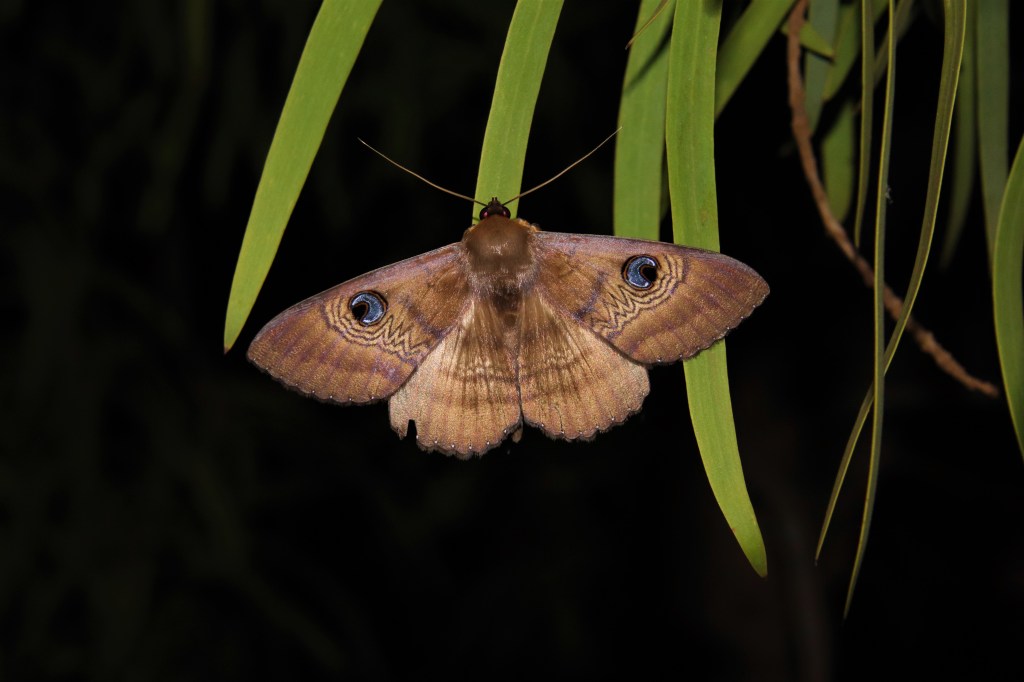
A quick spotlight at Heartlea revealed both Brushtails and a Ringtail Possum. I elected to return to Boyup Brook via Distributor and Westbourne Rds. As the road approached a dry creekbed with associated thick vegetation there were two small wallabies in the middle of the road, a female Tammar with Joey.
I stopped the car to approach on foot for a photo but forgot to turn-off the car headlights. The mother hopped off into the bush but the joey seemed dazzled by the headlights. It thought I was mum and hopped upto my leg.
The photo was forgotten because of concern the pair would be separated, and so I returned to the car to switch off the headlights relieved to see the joey hopping in the direction of mum.
The following morning I was out in the forest early to beat the heat on a day predicted to reach 41C. The morning was busy with four Brush Wallabies and an Emu with two stripey chicks seen, but not the evasive Numbat.
That afternoon 25kms away in the small township of Hester a power pole broke in the strong afternoon winds igniting a fire, power was cut to Boyup Brook, so despite reservations about finding wildlife in the intense heat an air-conditioned car was the only place to find reprieve. As I set off for the forest a menacing plume of smoke dominated the late afternoon sky.
Smoke Plume from the Hester Fire.
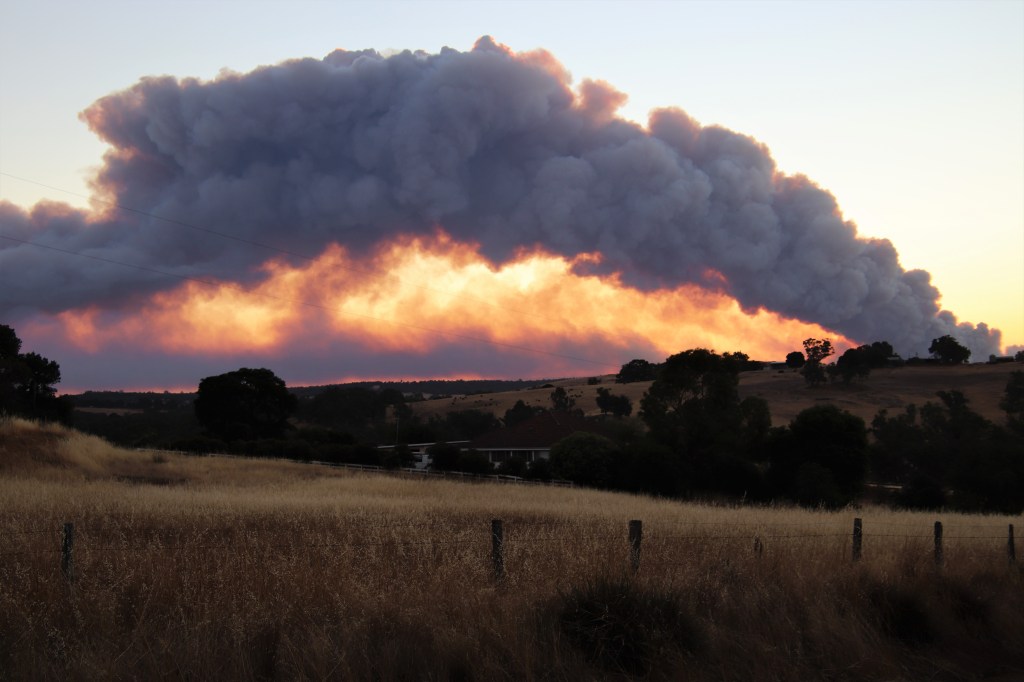
The forest at Perup felt like a forbidding place, choked with smoke under an evil orange sky. It was still baking hot and so the lack of Numbats wasn’t surprising. The spotlight ahead that night would be a short one, the combined exhaustion resulting from the driving, heat and late nights had finally caught up.
A drive on Distrubutor Rd saw the usual Brushtail and Ringtail Possums as well as a Woylie that stubbornly refused to move off the road, focused intently on devouring a morsel.
When it finally hopped off I investigated and found all that remained of the meal was the wing casings of a beetle, demonstrating the omnivorous habit of this species.
The Woylie wasn’t the only wildlife encountered on the road, a little later a Tawny Frogmouth flew up into a marri from the road where it had ambushed a moth.
Tawny Frogmouth.

That was it, I was done, it had been tough conditions over the weekend. Time to head home.
xxxxxxxxxxxxxxxxxxxxxxxxxxxxxxxxxxxxxxxxxxxxxxxxxxxxxxxxxxxxxxxxxxxxxxxxxx
It had been great to spend time in Perup over Summer. The cottages at the guesthouse were as comfortable and homely as I had remembered and are still very reasonably priced. The wildlife at the guesthouse indeed throughout Tone-Perup Reserve seems to be in greater numbers than in previous years, which I suspect may be the result of feral cat control methods being deployed.
In common with many West Australians I look forward to travelling interstate and overseas again, but I know that I will be back to see the Magical Marsupials at Perup in the future, this amazing forest has a hold on me and doesn’t let go…..
#QuollingAround
Lovely images as usual, Jim. I can only imagine how maddening it must have been to find a numbat on the road and am glad you also found the lovely live male. I couldn’t agree with you more that a speed limit of 110 is not appropriate. I think cruise controls are bad news in wildlife sensitive areas and try not to use mine any more just so natural deceleration gives birds a few extra metres before the brakes get to do their thing. Thanks for sharing.
LikeLike
Thanks Dan. Cruise control definitely make the driver complacent in wildlife areas, bull bars are another device that encourages bad driving in wildlife areas. I refuse to fit one to my 4WD so that I am suitably cautious driving at night…
LikeLike
Hi Jimmy – thanks so much for sharing your incredible stories of Perup! You are certainly our biggest advocate and we love having you to stay so that you can spread the word and share your experiences with people looking to have a unique wildlife experience in our neck of the forest! Your photos are incredible and we can only hope that other visitors get to see even a portion of what you do when they come here. See you next time 🙂
LikeLike
Thanks guys! It’s easy to advocate for such a fabulous eco-retreat. Keep up the good work!
LikeLike
Hello Sir! Epic! Thank you for sharing these wonderful stories, experiences and Pictures! Walking through the Tassie Bush at night, watching out for all the creatures coming across, is amongst the best memories in my life. Hope to get to WA some day in the future as well. Perups Nature Guesthouse sounds like heaven on earth… If i experience only 1% of what you have seen in my whole lifetime, i die as a happy man. Greetings from the other side of the planet! Tom
LikeLike
Thanks for you kind words Tom, glad you enjoy the blog. I absolutely share your joy of the Tassie bush, in fact often at night when I have had a busy day and am struggling to fall asleep, I take my mind back to Mount Field NP after dark to drift off. Perup Nature’s Guesthouse is probably the nearest thing we have to the Tassie bush here in WA, so many beautiful mammals. I hope you make it here one day….
LikeLike
Yes! Mount Field is awsome! – Other favourites of mine were Loongana, Bruny Island and camping on Maria Island. But there are just too many places to name them all, actually it doesn´t matter where you go, you stumble across wildlife everywhere in TAS… WA: If i ever make it there: i had on my wishlist Dryandra (for Numbat-spotting) and “Barna Mia Nocturnal wildlife experience” – is is worth going there or better going straight to Perups? Greetings from Bavaria, Tom
LikeLike
Although Dryandra Woodland and Perup have many of the same mammal species they are entirely different forests. Dryandra being an open drier woodland than the wetter denser forest at Perup. They are both fabulous places and it would definitely be worth visiting both.
LikeLike
Your photos are amazing! You’ve seen so many of our beautiful west aussie animals!
LikeLike
Thanks 😊 the nature here is very special indeed
LikeLiked by 1 person